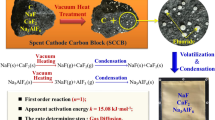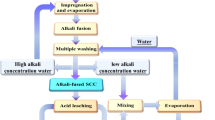Abstract
The spent carbon cathode (SCC) produced in the aluminum electrolysis process has been listed as hazardous waste due to excessive soluble fluoride and cyanide. In a high-temperature vacuum environment, the soluble fluoride and cyanide in SCC can be evaporated and decomposed, respectively. As a result, its impact on the environment can be eliminated. The remains and volatiles can be collected for resource use. Based on the analysis of SCC chemical composition and phase structure, thermodynamic parameters of evaporation reactions were calculated by FactSage. The effects of treatment temperature and particle size of SCC on the removal of soluble fluoride and cyanide were further investigated by experiment. A suitable treatment condition, in which SCC particle size is 1.000–3.000 mm, at 1000 ºC for 2 h at vacuum conditions of 10 Pa, was obtained. The removal rate of soluble fluoride and cyanide in treated SCC reached 91.10% and 99.33%, and carbon content reached 89.89%. Combined with the analysis of TG-DSC and particle profile scan, the evaporation reaction mechanism by high-temperature vacuum treatment (HTVT) was analyzed. The work will be helpful for the development of new SCC treatment process.
Graphical Abstract











Similar content being viewed by others
References
Breault R, Poirier S, Hamel G, Pucci A (2011) A “green” way to deal with spent pot lining. Al Int Today 23:22–24
Holywell G, Breault R (2013) An overview of useful methods to treat, recover, or recycle spent potlining. JOM 65:1441–1451. https://doi.org/10.1007/s11837-013-0769-y
Mahinroosta M, Allahverdi A (2018) Enhanced alumina recovery from secondary aluminum dross for high purity nanostructured γ-alumina powder production: kinetic study. J Environ Manag 212:278–291. https://doi.org/10.1016/j.jenvman.2018.02.009
Ishak R, Laroche G, Lamonier JF, Ziegler DP, Alamdari H (2017) Characterization of carbon anode protected by low boron level: an attempt to understand carbon-boron inhibitor mechanism. ACS Sustain Chem Eng 5:6700–6706. https://doi.org/10.1021/acssuschemeng.7b00945
Jing S (2021) Global primary aluminum production 65.27 million tonnes in 2020, up 2.53% year-on-year. www.cnal.com. https://news.cnal.com/2021/01-21/1611196974563919.shtml. Accessed 21 Jan 2021.
Qiu ZX, Zhai XJ, Lu HM, Wang ZW, Li B, Li WH (1999) Comprehensive utilization of spent potlining materials in aluminum industry. Light Met 11:42–44. https://doi.org/10.13662/j.cnki.qjs.1999.11.012
Lisbona DF, Steel KM (2008) Recovery of fluoride values from spent pot-lining: precipitation of an aluminium hydroxyfluoride hydrate product. Sep Purif Technol 61:182–192. https://doi.org/10.1016/j.seppur.2007.10.012
Xie MZ, Zhao HL, Wu ZG, Liu W, Li RB, Feng FQ (2020) Study on kinetics of vacuum heat treatment process of the spent cathode carbon blocks from aluminum smelters. J Sustain Metall 6:715–723. https://doi.org/10.1007/s40831-020-00311-5
Nunez P (2020) Developing guidance to support sustainable spent pot lining (SPL) management across the aluminum industry. JOM 72:3334–3340. https://doi.org/10.1007/s11837-020-04301-6
Sun G, Zhang G, Liu JY, Xie WM, Kuo JH, Lu XW, Buyukada M, Evrendilek F, Sun SY (2019) Thermogravimetric and mass-spectrometric analyses of combustion of spent potlining under N2/O2 and CO2/O2 atmospheres. Waste Manag 87:237–249. https://doi.org/10.1016/j.wasman.2019.01.047
Chandra S, Chauhan LKS, Murthy RC, Saxena PN, Pande PN, Gupta SK (2005) Comparative biomonitoring of leachates from hazardous solid waste of two industries using Allium test. Sci Total Environ 347:46–52. https://doi.org/10.1016/j.scitotenv.2005.01.002
Palmieri MJ, Andrade-Vieira LF, Cardoso Trento MV, de Faria Eleuterio MW, Luber J, Davide LC (2016) Cytogenotoxic effects of spent pot liner (SPL) and its main components on human leukocytes and meristematic cells of Allium cepa. Water Air Soil Pollut 227:156–165. https://doi.org/10.1007/s11270-016-2809-z
Ospina G, Hassan MI (2017) Spent pot lining characterization framework. JOM 69:1639–1645. https://doi.org/10.1007/s11837-017-2437-0
Andersen JN, Bell N (1979) Modified pyrohydrolysis process for spent aluminum reduction cell linings. U.S. Patent No. 4160808 A. Accessed 10 July 1979
Bell N, Andersen JN, Lam HH (1978) Process for the utilization of waste materials from electrolytic aluminum reduction systems. U.S. Patent No. 4113832 A. Accessed 12 Dec 1978
Lu HM, Qiu ZX (1997) Study on comprehensive utilization technique for treating spent potlining of aluminium electrolysis cells by flotation method. Metal Mine 6:32–35
Li N, Li RX, Xie G, Hou YQ, Yu XH, Chen L, Wang ZX (2013) Separating carbon and electrolyte in spent pot linings by floatation. Light Met 5:23–27. https://doi.org/10.3969/j.issn.1002-1752.2013.05.007
Lisbona DF, Somerfield C, Steel KM (2012) Leaching of spent pot-lining with aluminum anodizing wastewaters: fluoride extraction and thermodynamic modeling of aqueous speciation. Ind Eng Chem Res 51:8366–8377. https://doi.org/10.1021/ie3006353
Lisbona DF, Somerfield C, Steel KM (2013) Leaching of spent pot-lining with aluminium nitrate and nitric acid: effect of reaction conditions and thermodynamic modelling of solution speciation. Hydrometallurgy 134:132–143. https://doi.org/10.1016/j.hydromet.2013.02.011
Shi ZN, Li W, Ren BJ, Wang ZW, Gao BL (2009) Study on reclaiming spent pot lining of aluminium electrolysis cells by alkaline leaching and acid leaching. Proceedings of the 10(th) China-Russia symposium on advanced materials and technologies. Jiaxing, Zhejiang, China, pp 728–731
Liu ZD, Yu XH, Xie G, Tian L, Tang HX (2012) Study on alkaline leaching and flotation process to deal with spent pot linings. Light Met. https://doi.org/10.3969/j.issn.1002-1752.2012.03.008
Personnet PB (2013) Treatment and reuse of spent pot lining, an industrial application in a cement Kiln. In: John Wiley & Sons (ed) Essential readings in light metals: electrode technology for aluminum production, volume 4. John Wiley & Sons, New Jersey, pp 1049–1056. https://doi.org/10.1002/9781118647745.ch141
Chen XP (2011) Latest status of processing technologies for spent potlining from aluminium smelters. Light Met 12:21–24
Li WX, Chen XP, Liu FQ, Luo ZS, Zhao L, CHALCO (2005) Harmless treatment method for spent pot lining of aluminum electrolytic cell. CHN Patent No. CN 200410042564.8. Accessed 23 Feb 2005
Li WX, Chen XP, Luo ZS (2008) Running results of the first SPL detoxifying pilot plant. Light Met 1:6–11. https://doi.org/10.3969/j.issn.1002-1752.2006.10.010
Xie MZ, Li RB, Zhao HL, Liu W, Lu TT (2020) Detoxification of spent cathode carbon blocks from aluminum smelters by joint controlling temperature-vacuum process. J Clean Prod 249:119370–119391. https://doi.org/10.1016/j.jclepro.2019.119370
Luo MY (2020) Study on separation of electrolyte and carbon from electrolytic aluminum spent cathode carbon block by vacuum distillation. KUST 05:1–84. https://doi.org/10.27200/d.cnki.gkmlu.2020.000887
Wang YW, Peng JP, Di YZ (2018) Separation and recycling of spent carbon cathode blocks in the aluminum industry by the vacuum distillation process. JOM 70:1877–1882. https://doi.org/10.1007/s11837-018-2858-4
Liang KT, Duan ZB (2015) The study on comprehensive utilization of waste cathode carbon blocks in dongxing aluminum industry company. JISCO Technology 2:1–5
Bao LF (2015) Research on comprehensive utilization of the spent cathode of aluminium cell. XAUAT 08:1–61. https://doi.org/10.7666/d.D559694
Chen SZ (2018) Research on the hydro-treatment of waste cathode carbon block in the production of electrolytic aluminum. KUST 01:1–63
Liu JL, Ma XM, Lü CM (1995) A study on the cyanogen removed from the wastecontaining cyanogen compound by burning. J HUCEA 6:65–70
Deng JP, Shen JX, Wang XG, Ren JX, Tian XW, Fan ZM, Qiang JF (2007) Study on temperature rule of inner heat magnesium smelting vacuum furnace. MR 21:402–404. https://doi.org/10.3321/j.issn:1005-023X.2007.z2.143
Zhao H, Liu F, Xie M, Liu W, Hong YS (2021) Recycling and utilization of spent potlining by different high temperature treatments. J Clean Prod 289:125704–125712. https://doi.org/10.1016/j.jclepro.2020.125704
Acknowledgements
This project was supported by the Shaanxi Provincial Social Development Tackling Project (2015SF259) fund.
Author information
Authors and Affiliations
Corresponding author
Ethics declarations
Conflict of interest
The manuscript has not been published before and is not being considered for publication elsewhere. All authors have contributed to the creation of this manuscript for important intellectual content and read and approved the final manuscript. The corresponding author declares that there is no conflict of interest.
Additional information
The contributing editor for this article was Mansoor Barati.
Publisher's Note
Springer Nature remains neutral with regard to jurisdictional claims in published maps and institutional affiliations.
Rights and permissions
About this article
Cite this article
Xin, X., Zhao, J., Hu, A. et al. High-Temperature Vacuum Treatment of Aluminum Electrolytic Spent Carbon Cathode. J. Sustain. Metall. 8, 1204–1214 (2022). https://doi.org/10.1007/s40831-022-00543-7
Received:
Accepted:
Published:
Issue Date:
DOI: https://doi.org/10.1007/s40831-022-00543-7




